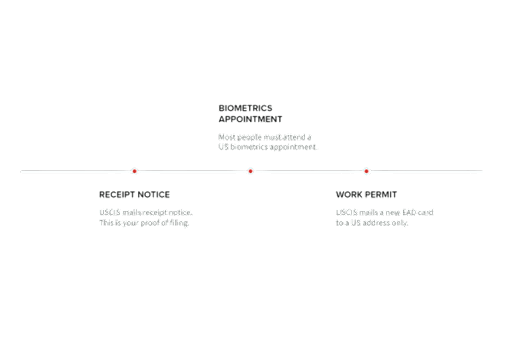
What's the Purpose of Form I-821? Some folks from other countries living in the USA can use Form I-821, also known as the "Temporary Protected Status (TPS) Application."
This happens when the Department of Homeland Security in the United States allows people from certain nations to stay temporarily for the following reasons:
- Wars
- Natural disasters
- Epidemic
- Extraordinary and short-term conditions
You can locate a comprehensive list of nations with TPS designation on the USCIS page for Temporary Protected Status (TPS).
While TPS is active, those who meet the criteria obtain specific benefits:
Being Allowed to Stay in the Country
The biggest advantage of a TPS is that you can remain in the United States while your home country is facing a crisis.
How long you can stay in the U.S. with TPS depends on the seriousness of the problem in your country and how long the Department of Homeland Security says your country is eligible for TPS protection.
Initially, you'll be allowed to stay for at least six months, which could be 18 months. If things don't get better in your home country, the DHS can decide to extend this time.
Because of this, some TPS holders have been able to live and work in the United States for more than ten years.
Getting the Right to Work
With Protected Status, you can also get permission to work in the United States, which is a big plus. If you have TPS, you can apply for a special work pass for the (EAD) Employment Authorization Documents. This paper lets you work in the U.S. for as long as your TPS says you can.
Remember that you'll have to fill out a different form for this.
Going Abroad for a While
You can go on short trips outside the United States if you have permission to travel. This special travel document allows you to leave the U.S. and return within the authorized time frame.
Usually, it permits multiple trips, but you can't stay outside the U.S. for more than 90 days. To get this travel document, you'll need to apply separately.
Who Can Apply for Temporary Protected Statuses (TPS)?
Not everyone can apply for a TPS. To be eligible, you typically need to be a citizen of a country designated for TPS. You must also have been living in the U.S. continuously from certain dates set for your country.
Before you fill out Form I-821, you need to make sure you meet all the requirements for TPS. According to USCIS, to qualify for TPS, you must:
- Be from a country that's been given TPS status, or if you don't have a nationality, you should have lived in a country that got TPS status.
- Apply during the open registration period or re-registration time, or you qualify for late filing during any extension of your country's TPS status.
- Have been physically present in the States since the date when your country was designated for Temporary Protected Statuses (TPS).
- Have continuously lived in the United States from the date specified for your country.
The rules have a special consideration for short, non-serious, and unintentional trips outside the United States. When you apply for Temporary Protected Statuses (TPS) or renew your registration, you must tell USCIS about any times you've been away from the U.S. since the CPP and CR dates. USCIS will decide if this exception applies to your situation.
You might not qualify for Temporary Protected Status (TPS) or be able to keep your current TPS if you:
- Have been found guilty of a serious crime (felony) or two (2) or more smaller crimes (misdemeanors) in the United States.
- Are not allowed to enter the U.S. as an immigrant due to specific reasons outlined in INA-section-212(a). These reasons often relate to serious crimes and security concerns, and they can't be forgiven.
- Are constrained to certain restrictions that prevent you from seeking asylum. These actions include persecuting someone or being involved in terrorism or encouraging it.
- Don't meet the requirements for continuous physical presence and residence in the United States.
- Don't meet the requirements for initial registration or late initial registration for Temporary Protected Statuses (TPS).
- If you're granted Temporary Protected Statuses (TPS), fail to renew it as required, unless you have a good reason.
Visit our site to keep updated of all the changes and latest information.
Understanding Continuous Residence & Physical Presence (CPP) for TPS
Candidates must meet CPP requirements to apply for Temporary Protected Status (TPS). This means being in the U.S. since your country's specified date.
For instance, if you're from Venezuela, the continuous physical presence date is March 9, 2021. You must have been in the U.S. since that date to apply for initial TPS.
When you complete the TPS I-821 Form, the Application for Temporary Protected Statuses, you must provide evidence of meeting the criteria.
This includes proving your entry to the U.S. occurred before the specified continuous physical presence date set by the Department of Homelands Security for your TPS-designated country. For specific continuous physical presences (CPPs) and continuous residences (CRs) dates by country, refer to the official USCIS TPS webpage.
Understanding Continuous Residence (CR) for TPS
You must meet the continuous residence criteria in order to be eligible for TPS and submit Form I-821. This requirement confirms that you have been residing in the US since the designated continuous residence date, as opposed to continuous physical presence.
For instance, Ukraine's continuous residence date is April 11th, 2022. To be eligible for an initial TPS application, you must have resided in the U.S. since the continuous residence date set by DHS. If you arrived after this date, you cannot file Form I-821.
When submitting your Temporary Protected Status (TPS) application using Form I-821, you must also furnish proof of meeting the continuous residence requirement. DHS designates a specific continuous residence date for each TPS country. Ensure your documentation shows your residence in the U.S. before and continuously after this date.
Visit the official USCIS TPS webpage for specific continuous physical presences (CPRs) and continuous residences (CRs) timeframes by nation.
Obtaining a Work Permit under TPS
Wondering about employment authorization through I-821 Form? As a TPS beneficiary, you can work in the U.S., but first, apply for the Employment Authorization Documents (EADs).
You may work in the US as a TPS beneficiary, but only after applying for and receiving an EAD (sometimes called a work permit or an employment authorization document).
You will be able to get a job while staying in the US for the predetermined amount of time thanks to the EAD. To apply for this benefit, you must submit an I-765 Form Application for Employment Authorizations. You have the option of filing simultaneously with I-821 Form or at any later schedule.
Normally, your EAD's validity aligns with your Temporary Protected Statuses, or TPS protection dates.
Traveling with TPS
Wondering if you can leave the U.S. after submitting Form I-821? Yes, you can, but you need a TPS travel permit, like Advance Parole. As of July 1st, 2022, USCIS replaced Advance Parole with a new travel authorization called I-512T Form, Authorizations for Travel by a Noncitizen to the United States. You may lose your TPS benefits if you don't get this authorization or return on time.
To request TPS travel approval, fill out and submit the I-131 Form, Applications for Travel Document, to USCIS. Once approved, you'll receive Authorizations for Travel by a Noncitizen to the United States.
This document permits overseas travel and return to the U.S. within your authorized timeframe. It often allows multiple reentries, but you can only stay outside the U.S. for up to 90 days in total.
Travel authorization lets you board a carrier and request lawful entry into the U.S. at a POE or Port-of-Entry. However, it doesn't assure entry. U.S. CBP or Customs & Border Protection will conduct necessary inspections, assessing your admissibility upon arrival.
If you have a criminal record or a history of unlawful immigration status, consult an immigration attorney before leaving the U.S.
Application for Temporary Protected Status (TPS)
Wondering what to include when mailing Form I-821? Your complete TPS application should include Form I-821, USCIS, and all necessary supporting documents.
Form I-821: Applying for Protection under TPS
To enroll or re-enroll in Temporary Protected Statuses (TPS), submit Form I-821 online or send the documentation to the specific mailing addresses provided on USCIS pages dedicated to TPS for individual countries.
Form I-765: Applying for Work Authorization
Applying for work authorization is not mandatory. If you decide to request a work permit, it will be processed more quickly if you include Form I-765 as part of your TPS application. You can also submit the application at any time while you have TPS.
USCIS fees
To check the USCIS fees, visit their website and look for a chart displaying the cost details.
Passport-Style Photos
You'll need to provide two matching color photos of yourself that meet the DOS's image standards. These pictures must be taken for a month before submitting your application.
Proof of Identity & Nationality
To prove your identity and nationality, you'll need to show that you belong to a country with TPS status. Include a photocopy of one of these documents:
- Passport displaying your photo, name, and birthdate.
- Birth certificate along with photo ID.
- Visa from a foreign consulate.
- National identity document from your home country, with your photo and/or fingerprint.
Proof of Initial Entry Date
To confirm your entry date to the United States, provide a photocopy of one of these documents:
- Passport
- I-94 Arrival or Departure Records
Proof of Continuous Residence
To show your ongoing stay in the United States since the required CR date for your TPS nation, offer one or more of these documents each month:
- Work records
- Rental receipts, utility bills, or letters from companies
- School records for you or your children in the U.S.
- Medical records for you or your children's treatment or hospital stays
- Statements from church, union, or organization officials familiar with you.
Here's a summary of the documents to include with your I-821 Form application. For a comprehensive list tailored to your situation, please consult the I-821 filing instructions.
I-821 Form Processing Times
Want to know how long it takes to get Temporary Protected Statuses (TPS) approval? Well, it varies. Typically, it's 10 to 18 months. The time depends on factors such as:
- your designated country,
- whether it's your first application
- or a renewal, and the service center handling your case.
During this period, USCIS will review your Temporary Protected Statuses request (I-821 Form). After that, USCIS will decide/approve your employment authorization application (I-765 Form).

As shown in the image above, Form I-821 can be completed in approximately 40 to 72 weeks. The typical application process may consist of the following three stages:
First Stage: Receipt Notice
A reception note is mailed by USCIS. This serves as your filing proof.
Second Stage: Biometrics Appointment
Most applicants have to show up in person for a US Biometrics appointment.
Third Stage: Work Permit
The USCIS mails a new EAD, Employment Authorization Document card to United States addresses only.
To get specific processing times for your Temporary Protected Statuses (TPS) country, check out USCIS official processing times.
FAQs For I-821 Form
How Much Does It Cost to Submit Form I-821 for Temporary Protected Statuses?
The fee for Form I-821 varies depending on specific factors. To find the fee details, check the USCIS website for a fee structure chart. Also, keep in mind that there are extra charges when filing Form I-765 for work authorization and Form I-131 for travel authorization.
Can I Apply for TPS Benefits After the Deadline?
Each country designated for Temporary Protected Statuses has specific registration periods. If you miss these deadlines, filing an I-821 application is considered a late submission for TPS and requires careful handling.
You may submit an initial application during an extension of your country's TPS period. If you qualify for late filing of your original Temporary Protected Statuses (TPS) application, you must still meet all eligibility criteria independently.
If you miss your country's Temporary Protected Statuses (TPS) re-registration period, USCIS might accept a late application with a valid reason. Include a letter explaining the delay with your Form I-821. Keep in mind late filing could lead to gaps in your employment authorization.
It's advisable to consult an immigration lawyer before pursuing a Temporary Protected Statuses (TPS) late filing.

